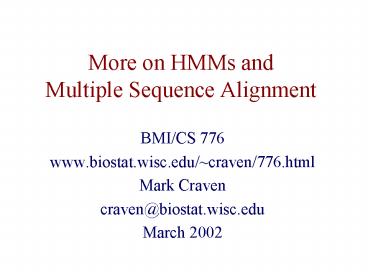More on HMMs and Multiple Sequence Alignment PowerPoint PPT Presentation
1 / 27
Title: More on HMMs and Multiple Sequence Alignment
1
More on HMMs andMultiple Sequence Alignment
- BMI/CS 776
- www.biostat.wisc.edu/craven/776.html
- Mark Craven
- craven_at_biostat.wisc.edu
- March 2002
2
Announcements
- readings for the week after Spring break
- Brown Botstein, Nature Genetics Supplement
- Eisen et al., Proc. National Academy of Sciences
- and more
3
Multiple Sequence AlignmentTask Definition
- Given
- a set of more than 2 sequences
- a method for scoring an alignment
- Do
- determine the correspondences between the
sequences such that the similarity score is
maximized
4
Motivation
- characterizing a set of sequences (e.g. some
class of DNA signals) - characterizing a protein family
- what is conserved
- what varies
- building profiles for searching
5
Multiple Alignment of SH3 Domain
Figure from A. Krogh, An Introduction to Hidden
Markov Models for Biological Sequences
6
The Structure of a Profile HMM
7
The Structure of a Profile HMM
- match states represent mostly conserved
positions in the sequence family - insert states represent subsequences that have
been inserted in some members of the family - delete states silent states representing
subsequences that have been deleted in some
members of the family
8
A Profile HMM Trained for the SH3 Domain
Figure from A. Krogh, An Introduction to Hidden
Markov Models for Biological Sequences
9
Model Selection for Profile HMMs
- we have assumed we are given a model of a
specified length how do we determine this
length? - heuristic approach
- choose an initial length learn parameters
- if more than x-del of Viterbi paths go through
delete state at position k, remove that position
from model - if more than x-ins go through insertions at
position k, add new positions to the model - iterate
10
Classifying Sequences Three Approaches
- choose threshold on Pr(x) that allows good
discrimination between positive cases and
negative cases - depends on length of x
- construct a null model run query sequence x
through both to see which results in greater
Pr(x) - construct a set of models for disjoint families
run query sequence x through all models to see
which results in highest Pr(x)
11
Choosing a Threshold
Figure from Krogh et al., Journal of Molecular
Biology 235, 1994
12
Modeling Protein Domains with an HMM
- there are lots of ways we can modify the basic
profile HMM architecture for particular modeling
tasks one such case is modeling protein domains
domain model
1 - p
1 - p
p
1 - p
1 - p
p
i
i
b
e
p
p
13
Other Methods Scoring a Multiple Alignment
- key issue how do we assess the quality of a
multiple sequence alignment? - usually, the assumption is made that the
individual columns of an alignment are
independent - well discuss two methods
- sum of pairs (SP)
- minimum entropy
14
Scoring an Alignment Sum of Pairs
- compute the sum of the pairwise scores
character of the kth sequence in the i th column
substitution matrix
15
Scoring an Alignment Minimum Entropy
- basic idea try to minimize the entropy of each
column - another way of thinking about it columns that
can be communicated using few bits are good - information theory tells us that an optimal code
uses bits to encode
a message of probability p
16
Scoring an Alignment Minimum Entropy
- the messages in this case are the characters in a
given column - the entropy of a column is given by
the i th column of an alignment m
count of character a in column i
probability of character a in column i
17
Dynamic Programming Approach
- can find optimal alignments using dynamic
programming - generalization of methods for pairwise alignment
- consider n-dimension matrix for n sequences
(instead of 2-dimensional matrix) - each matrix element represents alignment score
for n subsequences (instead of 2 subsequences) - given n sequences of length L
- space complexity is
18
Dynamic Programming Approach
- given n sequences of length L
- time complexity is
if we use SP
if column scores can be computed in
19
Heuristic Alignment Methods
- since complexity of DP approach is exponential in
the number of sequences, heuristic methods are
usually used - progressive alignment construct a succession of
pairwise alignments - CLUSTALW
- star approach
- etc.
- iterative refinement
- given a multiple alignment (say from a progessive
method) - remove a sequence, realign it to profile of other
sequences - repeat until convergence
20
Star Alignment Approach
- given n sequences to be aligned
- pick one sequence as the center
- for each determine an optimal
alignment between and - aggregate pairwise alignments
- return multiple alignment resulting from
aggregate
21
Star Alignments Picking the Center
- try each sequence as the center, return the best
multiple alignment - compute all pairwise alignments and select the
string that maximizes
22
Star Alignments Aggregating Pairwise Alignments
- once a gap, always a gap
- shift entire columns when incorporating gaps
23
Star Alignment Example
Given
ATGGCCATT ATTGCCATT
ATTGCCATT
ATGGCCATT
ATCCAATTTT
ATC-CAATTTT ATTGCCATT--
ATCTTCTT
ATTGCCGATT
ATTGCCATT
ATCTTC-TT ATTGCCATT
ATTGCCGATT ATTGCC-ATT
24
Star Alignment Example
- merging pairwise alignments
alignment
present pair
ATTGCCATT ATGGCCATT
ATGGCCATT ATTGCCATT
1.
ATC-CAATTTT ATTGCCATT--
ATTGCCATT-- ATGGCCATT-- ATC-CAATTTT
2.
25
Star Alignment Example
alignment
present pair
ATCTTC-TT ATTGCCATT
ATTGCCATT-- ATGGCCATT-- ATC-CAATTTT ATCTTC-TT--
3.
ATTGCCGATT ATTGCC-ATT
ATTGCC-ATT-- ATGGCC-ATT-- ATC-CA-ATTTT ATCTTC--TT-
- ATTGCCGATT--
4.
26
Methods for Multiple Sequence Alignment
27
Probabilistic vs. Other Multiple Alignment Methods
- conventional methods use uniform substitution
scores gap penalties for all regions of
sequences - an HMM can score things differently in different
regions (e.g. highly conserved vs. other regions)

